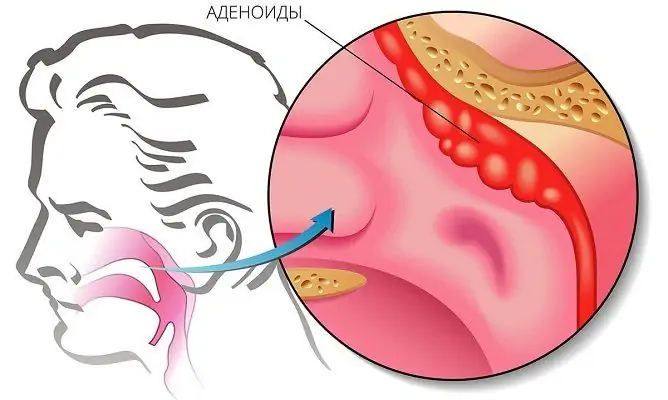- Author Rachel Wainwright [email protected].
- Public 2023-12-15 07:39.
- Last modified 2025-11-02 20:14.
Serous meningitis
The content of the article:
- Causes and risk factors
-
Serous meningitis symptoms
- Acute lymphocytic choriomeningitis
- Tuberculous meningitis
- Fungal meningitis in patients with HIV infection
- Serous meningitis with mumps (mumps)
- Diagnostics
- Serous meningitis treatment
- Possible complications and consequences of serous meningitis
- Forecast
- Prevention
Serous meningitis is a serous inflammation that affects the pia mater of the brain, accompanied by the formation of serous exudate, which includes some elements of blood cells and 2-2.5% protein.

Serous meningitis most commonly affects children ages 3-6
The disease can both be caused by infectious agents (fungi, viruses, bacteria), and be aseptic, non-infectious.
The inflammatory process in serous meningitis does not lead to cell necrosis and is not complicated by purulent tissue fusion. Therefore, this disease, in contrast to purulent meningitis, has a more favorable prognosis.
Serous inflammation of the meninges most often affects children aged 3-6 years. In adults, serous meningitis is diagnosed extremely rarely, in patients 20-30 years old.
Causes and risk factors
In 80% of cases, the cause of serous meningitis in adults and children is a viral infection. The causative agents of the disease can be:
- Epstein-Barr virus;
- measles virus;
- poliomyelitis virus;
- influenza virus;
- herpes simplex virus;
- adenoviruses;
- cytomegalovirus;
- enteroviruses;
- paramyxoviruses.
Much less often, a bacterial infection leads to the development of serous meningitis, for example, infection of a patient with a Koch stick (the causative agent of tuberculosis) or pale spirochete (the causative agent of syphilis). It is extremely rare that the disease has a fungal etiology.
Serous meningitis of an infectious nature develops in patients with weakened immunity, when the body's defenses are unable to cope with the pathogenic microflora.

Causes of serous meningitis
The routes of infection can be different (water, contact, airborne). The waterborne route of transmission is most typical for enteroviruses. That is why serous meningitis of enteroviral etiology is mainly diagnosed at the height of the swimming season, that is, in the summer months.
The development of aseptic serous meningitis is not associated with any infection. The reasons in this case may be:
- systemic diseases (periarteritis nodosa, systemic lupus erythematosus);
- brain cysts;
- tumors of the brain and its membranes.
In clinical practice, there is also a special form of serous meningitis - Armstrong's meningitis (lymphocytic viral choriomeningitis). The causative agent is a virus, and the reservoir of infection is rats and mice. The virus enters the human body when eating food and water contaminated with biological secretions of infected rodents (nasal mucus, feces, urine).
Serous meningitis symptoms
The incubation period for viral serous meningitis is 3 to 18 days. The disease begins with a sudden rise in body temperature to high values (40-41 ° C). Intense headache and symptoms of intoxication appear, which include:
- pain in muscles and joints;
- general weakness;
- weakness;
- lack of appetite.
In viral serous meningitis, the temperature curve is often biphasic: the body temperature remains at high values for 3-4 days, after which it decreases to subfebrile (below 38 ° C), and after a few days it rises again to 40-41 ° C.
The headache is permanent and is not relieved with conventional pain relievers. It intensifies under the influence of external stimuli (noise, harsh sound, bright light).
Other symptoms of serous meningitis of viral etiology are:
- nausea;
- repeated vomiting that does not bring relief;
- hyperesthesia (general and cutaneous), i.e. hypersensitivity to stimuli.
Patients tend to lie in a dark and quiet room, avoiding unnecessary head movements. To alleviate the condition, they take a forced pose, called the "Pointing Dog Pose" (lying on their side, head thrown back as much as possible, arms and legs bent at the joints and pressed against the body with force).
Viral serous meningitis in adults and children in many cases is accompanied by the appearance of a symptom complex characteristic of ARVI (sore throat, cough, nasal congestion, conjunctivitis).
With damage to the cranial nerves appear:
- drooping of the upper eyelid;
- difficulty swallowing;
- strabismus;
- double vision.
A characteristic symptom of serous meningitis is severe stiffness (tension) of the muscles in the back of the neck, which prevents the patient from reaching the chin to the sternum.

Typical symptoms of serous meningitis in children
Patients may experience drowsiness, mild stupidity. More severe impairments of consciousness, such as stupor or coma, are not typical for serous meningitis, and if they are present, you should think about a different diagnosis.
In children, against the background of the disease, a whiny and capricious state develops, convulsions can be observed. With unclosed fontanelles, their bulging is clearly visible. If the child is lifted by the armpits and held in weight, then he bends his legs at the knee and hip joints, pulling them to the stomach. This is called the hanging symptom or Lessage symptom.
Some types of serous meningitis have a special clinical picture, we will consider them separately.
Acute lymphocytic choriomeningitis
With this form, not only the pia mater is drawn into the serous inflammatory process, but also the plexus of the blood vessels of the ventricles of the brain. The incubation period lasts from 6 to 13 days. In about half of patients, the disease begins gradually. There is general malaise, pain and sore throat, nasal congestion, body temperature rises. The manifestation of symptoms of serous meningitis occurs only at the time of the second wave of an increase in body temperature. In the other half of the patients, the disease occurs suddenly with a sharp increase in body temperature, cephalgia (headache), severe intoxication and the appearance of symptoms characteristic of serous meningitis.
Tuberculous meningitis
Serous meningitis, caused by Koch's bacillus, occurs in patients suffering from tuberculosis of various localization (lungs, genitals, kidneys, larynx). It has a subacute character. Tuberculous meningitis begins with a prodromal period, which lasts up to 15-20 days. Characteristic for him:
- decreased appetite;
- low-grade fever (37.5-38 ° C);
- moderate headache;
- excessive sweating;
- general weakness;
- decrease in physical and mental capacity for work.
Meningeal symptoms develop gradually. Some patients have mild ptosis, slight squint, and decreased visual acuity.
If specific anti-tuberculosis therapy is not carried out, then over time, focal neurological symptoms appear (paresis, aphasia, dysarthria).
Fungal meningitis in patients with HIV infection
In patients with AIDS, fungal serous meningitis has few clinical manifestations. The disease progresses very slowly, over several weeks. The body temperature usually does not exceed 38 ° C, and the headache is mild. Intracranial hypertension (liquor-hypertensive syndrome) develops in no more than 40% of patients. Meningeal symptoms are mild, and in some cases are not defined at all.
Serous meningitis with mumps (mumps)
This form of serous meningitis (paramyxovirus) is three times more likely to affect males. In 80% of cases, the clinical picture of serous meningitis occurs 1-3 weeks after the onset of mumps. In 10%, the symptoms of serous meningitis precede, and in the remaining 10% develop in parallel with the symptoms of mumps.
For paramyxovirus serous meningitis, a violent onset is characteristic. In patients, the body temperature quickly rises to high values, an intense headache occurs, nausea, vomiting appear, and a pronounced meningeal syndrome develops. In addition, they are characterized by:
- seizures;
- paresis;
- ataxia (impaired coordination of movements);
- stomach ache;
- signs of damage to the cranial nerves.
The penetration of the mumps virus into other organs is accompanied by the development of adnexitis, orchitis, pancreatitis.
Diagnostics
It is possible to assume the presence of serous meningitis in a patient on the basis of a characteristic clinical picture, in particular the following signs:
- "Pointing Dog Pose";
- positive symptoms of Brudzinsky, Kerneg;
- muscle stiffness in the back of the neck;
- positive symptom of Lesage (in children of the first years of life).
To establish the cause that caused the development of the inflammatory process in the meninges, it is necessary to collect an anamnesis, paying attention to the features of the onset of the disease, the presence of contact with sick persons.
In a general blood test for serous meningitis, signs of an inflammatory process are revealed, namely leukocytosis, a shift in the leukocyte formula to the left and an increase in ESR.
To identify the pathogen, virological studies are carried out using ELISA, RIF, PCR, and bacterial inoculation of discharge from the nose and throat is also performed.
Confirmation of the diagnosis of serous meningitis is possible based on the results of laboratory examination of cerebrospinal fluid. A sign of serous inflammation is an increased content of protein in the cerebrospinal fluid. With tuberculous and fungal meningitis, a decrease in glucose concentration is noted in the cerebrospinal fluid. The predominance of neutrophils in the cerebrospinal fluid is characteristic of bacterial serous meningitis, but if the disease has a viral etiology, then lymphocytes predominate.

Confirmation of the diagnosis "serous meningitis" is carried out on the basis of analysis of cerebrospinal fluid
In syphilitic and tuberculous serous meningitis, pathogens are detected by microscopy of cerebrospinal fluid smears, stained in a special way.
Ophthalmoscopy, RPR test (diagnosis of syphilis), tuberculin tests, ECHO-EG, MRI of the brain, electroencephalography are used as additional diagnostic methods.
Serous meningitis must be differentiated from subarachnoid hemorrhage, arachnoiditis, tick-borne encephalitis, purulent meningitis, meningococcal, pneumococcal, or any other etiology.
Serous meningitis treatment
If serous meningitis is suspected, the patient is hospitalized. In the hospital, etiotropic therapy is started. For herpetic meningitis, acyclovir is prescribed, for other types of viral meningitis - interferons. If the patient has a reduced immune response, then immunoglobulin is used simultaneously with antiviral drugs.
Identifying the causative agent of serous meningitis takes time. Therefore, after sampling the material for bacterial sowing, the patient begins to inject broad-spectrum antibiotics.
Treatment of serous meningitis caused by tuberculous mycobacteria is carried out with anti-tuberculosis drugs.
In addition, syndrome therapy is performed. Non-steroidal anti-inflammatory drugs are used to reduce body temperature. With increased intracranial pressure, diuretics are prescribed for dehydration. Relief of convulsive syndrome requires the use of valproic acid, tranquilizers. With a pronounced intoxication syndrome, detoxification therapy is necessary.

Until the causative agent of serous meningitis is identified, the patient is administered broad-spectrum antibiotics
To protect brain cells from damage, it is necessary to use neurotropic and neuroprotective drugs (hydralizate of the pig's brain, B vitamins, nootropics).
Possible complications and consequences of serous meningitis
After suffering serous meningitis, some patients retain for several months:
- asthenia;
- headaches;
- decreased concentration of attention.
These phenomena gradually disappear.
The consequences of serous meningitis of tuberculous etiology may be much more serious. Untimely initiation of specific therapy for the disease leads to chronicity of the inflammatory process, in severe cases, patients die on the 23-25th day from the moment the first symptoms appear.
Forecast
Timely treatment of serous meningitis ensures rapid improvement in patients' condition. The average duration of the disease is 10-14 days. In most cases, serous meningitis ends with complete recovery.
Prevention
Prevention of the development of serous meningitis includes:
- a healthy lifestyle (proper nutrition, playing sports, giving up bad habits);
- vaccination against tuberculosis, measles, mumps;
- adequate treatment of infectious diseases;
- compliance with personal hygiene requirements.
YouTube video related to the article:

Elena Minkina Doctor anesthesiologist-resuscitator About the author
Education: graduated from the Tashkent State Medical Institute, specializing in general medicine in 1991. Repeatedly passed refresher courses.
Work experience: anesthesiologist-resuscitator of the city maternity complex, resuscitator of the hemodialysis department.
The information is generalized and provided for informational purposes only. At the first sign of illness, see your doctor. Self-medication is hazardous to health!






